Okay, before going any farther with the story of Metroid, lets visit a major character in the Metroid series.
The title of the series: Metroid, is a conglomeration of the words metro, meaning rapid transit and android. This is obviously speaking of Samus, being the android-like main character of the first game. So how did this become the name of her arch-nemeses?
We never find out.
The actual creatures, revealed by the storyline of Metroid Prime, were created by the Chozo, an ancient race and foster parents of Samus. They were created to eradicate a dangerous parasite Samus encounters in Metroid Fusion, the X-parasite. Metroids have appeared in every Metroid game except Metroid: hunters.
A study and reflection of the Metroid series in a Video Game and Culture class.
Thursday, February 24, 2011
The next installment in the Metroid Series is Metroid II: Return of Samus. Utilizing save states and the portability of the Gameboy brought this game a lot of success after it's debut in 1991. The developers at Nintendo took the original metroid to a whole new level with this title. They overhauled the graphics and gave Samus a very human-like appearance. She was taller and her suit had much more detail.
The story followed Samus through the caverns of SR-388. A small planet which is home to her nemesis, the metroids. Her task this time was to destroy every last one of the creatures and therefore force them into extinction.
Althought limited by the greyscale technology of the Gameboy, the sound continued to excel. It had less of a soundtrack in this edition and more of a context based background noise. Music was not constantly playing, yet the sounds of the creatures roaming the dark caves made up the soundtrack.
Metroid II saw the release of more interesting upgrades to Samus' suit. She could now jump in her morph ball and had more beams at her disposal. The game still did not feature a map and this title is arguably more confusing than the last.
The story followed Samus through the caverns of SR-388. A small planet which is home to her nemesis, the metroids. Her task this time was to destroy every last one of the creatures and therefore force them into extinction.
Althought limited by the greyscale technology of the Gameboy, the sound continued to excel. It had less of a soundtrack in this edition and more of a context based background noise. Music was not constantly playing, yet the sounds of the creatures roaming the dark caves made up the soundtrack.
Metroid II saw the release of more interesting upgrades to Samus' suit. She could now jump in her morph ball and had more beams at her disposal. The game still did not feature a map and this title is arguably more confusing than the last.
Movie Influences


In the time of release for Metroid, a very iconic movie was also hitting it's peak influence. Robocop was a huge hit in 1987, possibly lending it's popularity to the similar character in Metroid. Being a US release, perhaps Robocop influenced Japanese culture during the time of Metroid's development.

Thursday, February 17, 2011
The beginning of the legacy
 The 1986 release of Metroid was an epic release from the claimed developers at Nintendo's R&D Team 1. The concept is hailed as a perfect combination between the platforming action of Super Mario Bros. and the open-ended exploration of The Legend of Zelda. Metroid is categorized as a sci-fi action adventure, and its style is a sidescrolling adventure. This was one of the first games to feature the password save system on the NES. The character Samus Aran, the protagonist of the series was perceived as a man for her first entry into the videogame world. Not until the very end of the story was she revealed as a woman, shocking players. There was even a code available so you could change the sprite of samus to a suit-less version of Samus where she can run around and shoot baddies in a bikini. The game featured elements such as rooms which are impossible to get through and a very difficult learning curve.
The 1986 release of Metroid was an epic release from the claimed developers at Nintendo's R&D Team 1. The concept is hailed as a perfect combination between the platforming action of Super Mario Bros. and the open-ended exploration of The Legend of Zelda. Metroid is categorized as a sci-fi action adventure, and its style is a sidescrolling adventure. This was one of the first games to feature the password save system on the NES. The character Samus Aran, the protagonist of the series was perceived as a man for her first entry into the videogame world. Not until the very end of the story was she revealed as a woman, shocking players. There was even a code available so you could change the sprite of samus to a suit-less version of Samus where she can run around and shoot baddies in a bikini. The game featured elements such as rooms which are impossible to get through and a very difficult learning curve.
Overview
 The metroid series started in 1986 with the NES release of Metroid. The series traditionally follows a 2D sidescrolling platformer style, but this design has been challenged in the last decade. The metroid history is full of interesting games and background. This blog will be discussing the various elements that helped this game become an iconic part of videogame history.
The metroid series started in 1986 with the NES release of Metroid. The series traditionally follows a 2D sidescrolling platformer style, but this design has been challenged in the last decade. The metroid history is full of interesting games and background. This blog will be discussing the various elements that helped this game become an iconic part of videogame history.
Subscribe to:
Comments (Atom)

